Q: How do you turn a super-rare, once in a lifetime pre-pro shot glass find into a run-of-the-mill glass in just a few seconds?
A: Take the original wrapper off.
Back in the day, numerous manufacturers were producing the cheap thin-walled shots that we know so well by the tens of thousands and in various different sizes (see a brief history). Some glass houses additionally offered the option of custom-labeling them with a vitreous compound designed to mimic acid-etching. The Huntington Tumbler Co. of Huntington, WV referred to this a “snow enamel etching”. After the label had been applied and adhered to the glass, the glasses were individually wrapped in a thin piece of paper and then boxed up by the dozen or stacked one inside the other (don’t try this at home – it’s only safe to do if the glasses are all the same size), packed in straw, and sold by the gross.
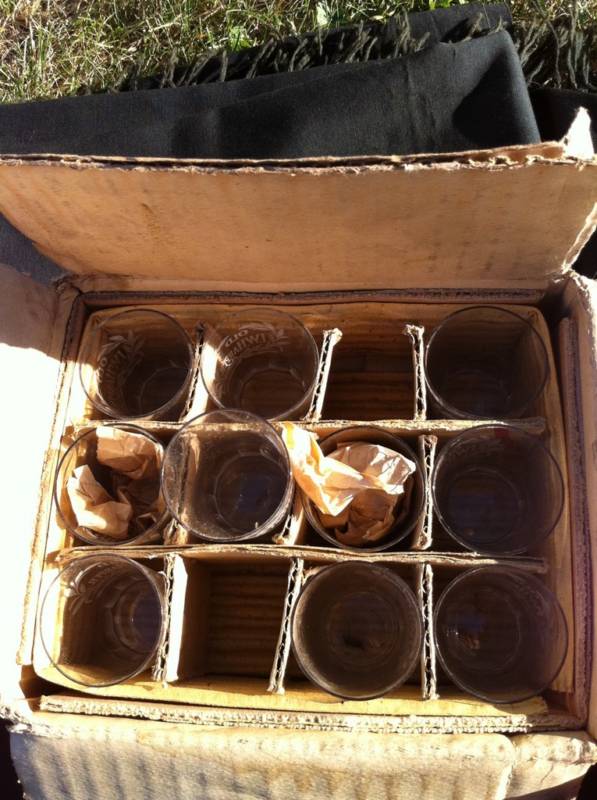
Fast forward 100+ years and there is precious little evidence of the original wrappers or documentation regarding how the glasses were prepared for shipping. The recipients were usually saloon owners, hotel bars, liquor dealers, or individuals who had received them as rewards for a mail order; presumably they were immediately unwrapped and placed on a bar or in a curio case for display. In my 35+ years of collecting, I’ve only ever seen two examples of a glass with its wrapper still pristine and intact (although I’ve had several near misses), which makes them rare beasts indeed.

Why are wrapped glasses so rare? There a two main reasons. The first is that the wrappers were thin and not designed to provide protection for a century or more. Boxes containing the wrapped glasses were often left forgotten in damp basements where water may have dripped on them, causing the cardboard boxes and paper wrappers within to rot (the glasses didn’t fare too well from such exposure either; the mineral deposits left behind may change the crystal structure of the glass and cause cloudiness). Wrapped glasses stored in a dry place were also at risk from the natural aging process. Over the years, the thin coverings may become very brittle and prone to disintegrate when handled (as in the example above).
Assuming that a wrapper does survive, then it’s at great risk of being removed and discarded by dealers and collectors. It’s easy to understand the dilemma when faced with a wrapped glass. Collectors want to display their glasses, and the display value of a glass wrapped in a grubby and most likely crumbling paper wrapper is close to zero. Heck, let’s just get rid of the wrapper and put the newly-minted glass on display. Totally understandable (I’ve done it myself with one of the Newvilles -see below).
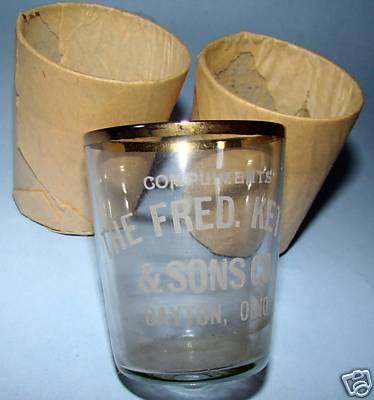
Dealers, on the other hand, just want to figure out what’s under the wrapper ASAP and then photograph it for listing on eBay. Again, who can blame them. Hopefully you get the idea, wrapped glasses are, um, RARE (pay attention dammit!!!!).
So you can imagine my excitement at two recent listings by eBay seller warren8426. Both were for Geo. Wissemann (Sacramento, CA.) glasses, one a Kentucky Standard No. 1, the other a Kentucky Standard O.K. (O.K. as in “Old Kentucky”). Naked Wissemann glasses in mint condition have been showing up for many years now, which is always a hint that a wrapped-glass treasure trove may exist somewhere, but the seller was kind enough to note in his listing “NEW OLD STOCK – REMOVED IT FROM IN ORIGINAL PAPER COVER THIS MORNING AND WASHED IT.”
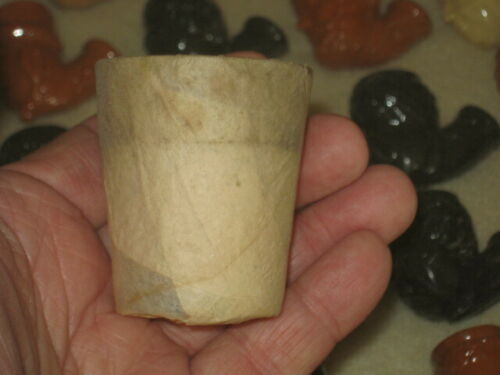
Swoon.
I’m ashamed to say that I’ve been buried in work and had completely missed the fact that both listings had included a photo of a wrapped glass until being given a heads up by a pre-pro regular (in case you’re wondering, the background in the image above shows a display case holding the seller’s CA goldrush pipe collection). I immediately contacted the seller.
Warren (warren8426), who is based in Stockton, CA., recounts that “these glasses were found by an Estate Sale company in Pebble Beach, CA. They came from a huge mansion on the 18th hole on the Pebble Beach golf course. They found a straw suitcase in a storage room that had about 30 wrapped shot glasses and 10 trays. I missed that sale. They sold 7 trays for $50 each and maybe one shot glass for $20. I met them at their next sale and arranged to buy what was left.” He was kind enough to send me photos of one of the trays that he had acquired, plus group photos of the glasses that he had managed to track down.
Needless to say, I purchased one of the wrapped “No. 1″s from him and two of the wrapped “O.K.”s, which more than doubled my lifetime collection of wrapped glasses.
Right now, you’re not doubt wondering what the value of a wrapped glass is vs. an unwrapped glass. Since they’re super-rare, you’d think that they would come at a premium price but that’s sadly (or not sadly, depending on your perspective) not the case. There are one or two specialist collectors I know who would give their eye teeth to get their hands on a wrapped glass, but they’re the exceptions – because it always comes back to display value for the majority of collectors. The display value of a wrapped glass is practically zero, but the value of an honest-to-God, minty-mint glass lying hidden beneath the wrapper is so much more. Personally, the history and hidden mysteries of a wrapped glass are priceless. I still have a couple of eye teeth left if anyone has one or two for sale….
Returning to the glass that I mentioned having removed from the wrapper (above). Back in 2002, a couple of mint-condition Newville Pure Rye Whiskey glasses from C. B. Wagner of Carlisle PA. were listed for sale by eBay seller pneumatic. Bob Rowe, the seller, is local to the area. The Newville glasses are classic pre-pro with a highly attractive design and a gorgeous gold rim. Bob was offering them in their original wrapper, along with a corkscrew, a couple of letterheads from C. B. Wagner, and a copy of Wagner’s liquor license (the Harper label in the grouping below was offered in later listings).
I’m not sure of the exact details of the find since they came to me from a collecting colleague in MA who had heard from a collecting colleague in AZ, who had heard it from his wife’s friend’s hairstylist – or something like that. The gist of the story was that Bob had discovered over 100 of these glasses in an attic in Carlisle, all neatly wrapped, stacked by the dozen, and packed in straw. I tried contacting Bob a little while ago through eBay for clarification but have yet to receive a response. I ended up buying several from him, two of which are shown below.
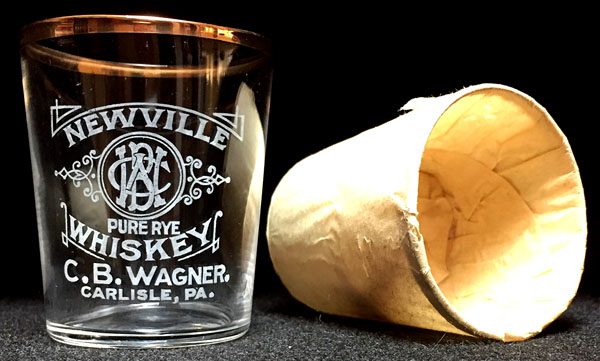
Bob has sold at least 30 of these glasses on eBay to date but I’m sure he has several more on hand. Bookmark him because he continues to list them periodically as buy-it-nows for the outrageous sum of $28 (the last one to list was back in November). Be warned – you’ll be forced to take the corkscrew and letterheads also. If you’re a serious collector, buy two and take the wrapper off one of them, just for the pure joy of seeing a gold-rimmed glass in truly mint condition. Yes, I know it’s destroying a little piece of history, but I think that there are enough these particular wrapped glasses still in circulation that it may be okay.
I’ll close by saying that in the past 30 days, 248 pre-pro glass auctions closed on eBay, 92 went unsold. The average price of glasses that did sell was $44.44. Happy hunting!

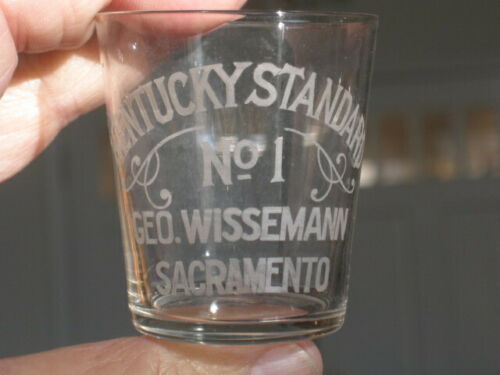

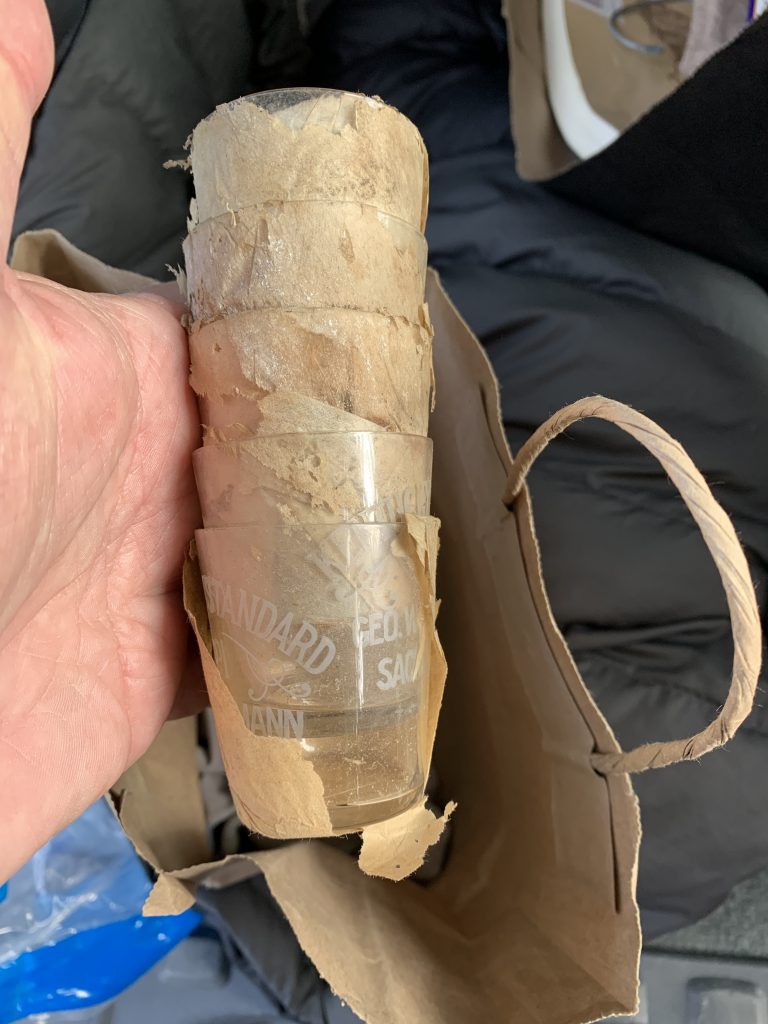
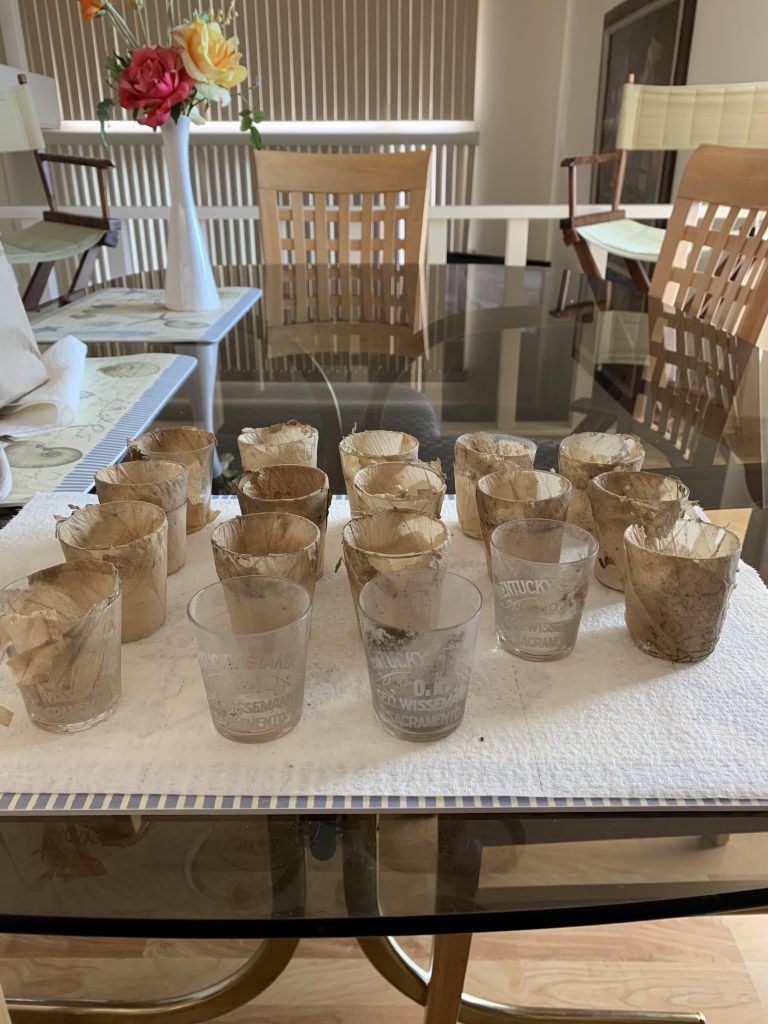
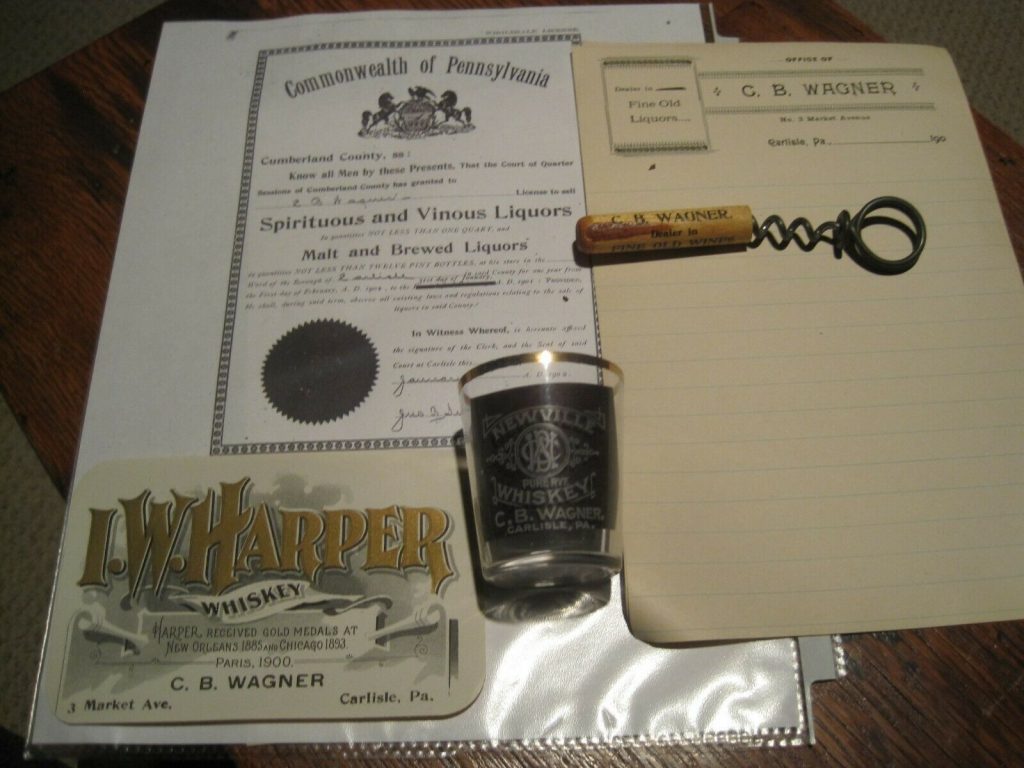
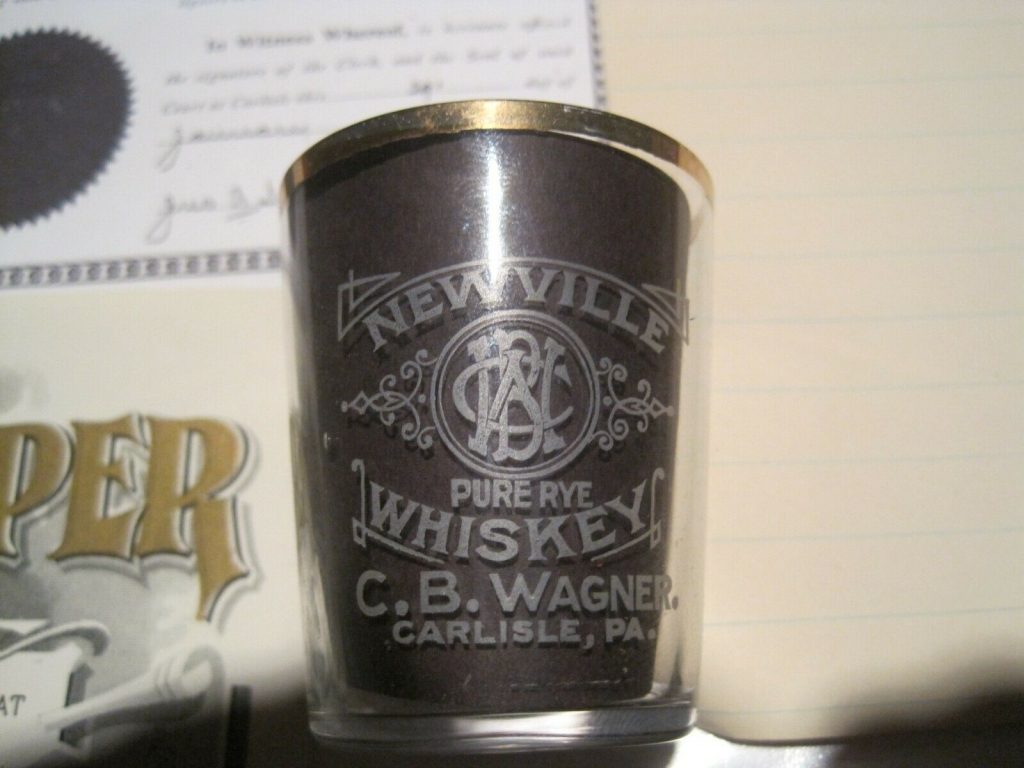
Bob Barnett once told me that glasses were packed in sawdust to prevent breakage. I wish now I had followed up and asked him how he knew that.